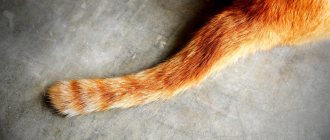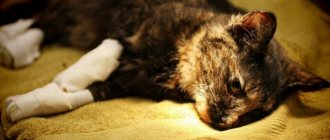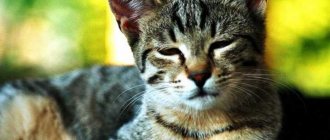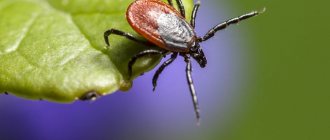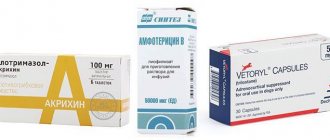Unfortunately, tooth extraction in cats is quite common, since many animal owners, out of ignorance, do not care for the cat’s oral cavity. Therefore, they come to the clinic with advanced cases and the teeth are removed.
Tooth extraction in cats occurs only when treatment no longer helps. It must be remembered that many dental diseases are asymptomatic, so it is necessary to periodically examine the oral cavity so that you do not have to resort to such a procedure.
In what cases does a veterinarian recommend tooth extraction?
Let's look at the cases in which teeth are removed.
- Incorrect placement of milk or molars, which interferes with the normal functioning of the animal - the soft tissues of the oral cavity are damaged.
- In severe cases, where conventional treatment has not yielded results - feline lymphoplasmacytic stomatitis.
- Teeth that are close to each other is called crowding. In this case, there is a risk of getting sick because Food will accumulate between the teeth and this will lead to an inflammatory process.
- Internal root resorption
- External root resorption
- Milk teeth that did not fall out on time on their own, but the molars have already begun to grow and the milk teeth interfere with the growth of new teeth.
- Teeth located under the gum mucosa are also subject to removal. They have not erupted, but a cyst may form under the gum and this will harm the adjacent teeth.
- The indication for tooth extraction is periodontal disease.
- Odontoclastic resorptive lesion of teeth – classes 2,3,4
Tooth extraction is carried out only under anesthesia. After tooth extraction, your pet must have the wound sutured, otherwise there is a risk of infection, and the wound will take a long time to heal.
Symptoms
A broken tooth may not bother a cat and it will not show any external signs. In severe cases, the animal may experience pain not only in the tooth itself, but even in the entire jaw and head. Typically, a manifestation of dental problems will be a cat’s refusal to eat, and a constant desire to hide somewhere. The following symptoms indicate that a cat has broken a tooth :
- The tooth changes color and shape, its location shifts,
- Swelling appears on the animal's face,
- The cat refuses to eat
- The animal refuses to play and does not bite toys.
© shutterstock
If your animal experiences similar symptoms, you should contact your veterinarian. A suspected broken tooth falls into the emergency category, and before starting therapy the animal must undergo the following studies :
- Pet examination,
- X-ray of the jaw,
- Examination of the tooth with a periodontal probe,
- Clinical and biochemical blood test.
The procedure for removing teeth from a cat or how to pull a tooth out for a cat
Provide your pet with proper dental care: brush his teeth at least once a week, periodically remove tartar, give vitamins and periodically visit a veterinarian for an oral examination. Even if a cat’s tooth was pulled out and everything else is fine, this does not mean that further care is not needed.
Only a veterinarian can remove a tooth from a cat after first administering anesthesia. If a cat's teeth have been removed, it is necessary to first check the condition of the gums in this place so that inflammation does not appear.
Preventive measures
It is necessary to resort to removal only in case of severe damage. The veterinarian carries out the procedure harmlessly for the cat, using special equipment and painkillers.
If the displacement is not critical, it is left in place. Such a deviation will not cause concern to the animal. If your pet’s behavior has changed, and he behaves as if something is in the way and is trying to pull it out with his paw, then you should go for an examination to the veterinarian. The tooth will be put back in its original place, and it will become invisible again. Do not try to carry out this procedure yourself; you may cause pain to the cat and develop an infectious disease and inflammation.
It is necessary to regularly examine the oral cavity and provide care. Brushing your teeth will help prevent the development of many diseases not only for people, but also for animals. It is worth remembering this and carefully cleaning the cavity once a week. Also, systematically taking vitamins will improve the health of the body and the condition of the teeth. They are mixed with food and given to the animal for a month once a year. After removal, it is important to continue care and inspection. Until the healing process is completed, there is a risk of complications.
The cat broke a tooth: what to do?
If your cat has a broken tooth. First of all, check whether there is inflammation, what condition the other teeth are in, whether it hurts the cat to eat, whether there is discomfort when eating, and in general, pay attention to the behavior of the animal; perhaps the cat has a toothache.
If a cat has a broken tooth and it does not cause concern to the animal, there is no need to do anything; at home this is not as important as for wild cats for hunting. If there are still nuances, something is confusing, it’s better not to delay.
If your cat breaks a tooth or knocks it out at the root, you can get a crown. In some cases, it is necessary to remove a cat's tooth. The same thing is done if the cat knocks out a tooth.
Causes
A tooth can break for many reasons. A small crack in the enamel leads to the destruction of dentin and exposure of the pulp, which can lead to tooth loss. The tooth root or crown may also be partially or completely damaged.
Typically, dental injuries in pets occur due to bad falls, car accidents, fighting with each other, or injuries to the jaw bones.
A pet’s teeth can break above, below or at the gum level, and the fracture itself can be either vertical or horizontal; subsequent treatment will depend on these indicators.
Cat's tooth is loose
If a cat's tooth is loose, there may be several reasons for this. An adult cat may have a loose tooth due to a lack of vitamins or poor nutrition. Also note that you should not give too much fish to your cat, as vitamin B is washed out of the animal’s body. If a kitten’s tooth is loose, it may be a baby tooth and will soon be replaced by a molar.
In any case, if you are not sure about the correctness of the treatment or prevention you have chosen, contact your veterinarian, he will really help determine the causes of the disease, and not just see the consequences.
| In our cattery you can “buy a real British kitten.” We have many different colors, we will help you choose and answer all your questions! |
Treatment
This process directly depends on the nature of the damage. Damaged dentin is treated with fluoride and sealant. If the fang is more damaged and cannot be restored to a healthy state by any means, it is removed.
You may be interested in: Ringworm in cats: types and main signs, treatment and prevention
In some cases, the animal is given a filling. Special plates are used if the crack is small. If the crack appeared because the jaw was injured and, in addition to problems with the teeth, abrasions and scratches appeared, then the jaw is treated first. The veterinarian is able to return the tooth to its original place if it has shifted. In this case, the main thing is to immediately contact a veterinary clinic, because an inflammatory process may begin.
Cats quickly adapt to life without a fang, and this will not affect his abilities or behavior in any way. The animal will be able to chew food easily and the absence of a fang will not cause any discomfort.
The process of diagnosing jaw fractures
So, the conclusion is simple - no matter what type of jaw fracture it is, the injured animal must be immediately taken to a veterinarian. To make an accurate diagnosis, he can use one of the methods described below. Let us emphasize once again that jaw fractures are an extremely painful injury . To conduct even the simplest examination, the animal must be given fairly powerful sedatives, otherwise it may die from painful shock. This is especially important when examining a broken jaw in a kitten.
Visual exploration
The most obvious and simple method. It is important to examine the animal’s jaws and understand how deep the wound channel is and what can be done to alleviate the pet’s condition. Considering that jaw fractures often result in thin and sharp fragments, it is not surprising that after injury, pieces of them pierce the skin and are clearly visible to the naked eye.
Before any further research is carried out, it is necessary to ensure that the animal's condition is stable. If the fracture was caused by a car collision, the cat must first be “stabilized” so that it does not die from internal bleeding or other severe post-traumatic consequences.
Visual inspection of the fracture
To visually determine the severity of a fracture, it must be seen. This is why the veterinarian will conduct an x-ray examination of the affected area. If the animal’s condition is alarming, or the case is complex, an MRI will not hurt. Only after collecting all the diagnostic information can it be determined which therapeutic strategy should be chosen.
Therapeutic techniques
The methods directly depend on the specific type of fracture. Let's look at the most common and effective treatment methods.
External immobilization
Used in cases of simple fractures . In this case, a special muzzle is placed directly on the muzzle, or a tight bandage is used. If the injury is relatively simple, therapy is limited to this.
External skeletal fixation
The jaw is held in place by externally applied plates, which in turn are held in place by special pins and bolts. After healing, all “foreign” implants are removed. This technique has proven itself in the treatment of open jaw fractures .
Internal reduction
In this case, the same metal plates and bolts are inserted during surgery. Unlike the previous technique, implants remain in the animal’s body throughout its entire subsequent life. The advantage of the technique is simpler postoperative care. This operation is often used to eliminate the consequences of damage to the symphysis .
Interosseous or interfragmentary “wiring”
A long, thin "wire" is inserted through the lower jaw, but remains under the tongue and is then passed outward to the opposite side. To prevent the implant from falling out, it is fixed with clamps. After healing, the “crossbar” is removed. The technique is often used in conjunction with the previous method to eliminate the consequences of severe fractures complicated by the formation of large bone fragments .
Attachment of the palatine bones
To prevent mixing of the split areas of the palatine bones, they must be firmly fixed by screwing to each other. It is not difficult to guess that this technique is used for fractures of the upper jaw . The advantage of this method is the ability to feed the animal independently during the entire treatment period. Of course, the cat should eat exclusively soft, pureed food.
Securing teeth
In case of fractures accompanied by loosening and damage to the teeth , they are also attached directly to the jaw using plates and flexible wires made of medical steel. Such “braces” are also removed after complete healing of post-traumatic injuries.
Partial or complete mandibulectomy
If the jaw is so damaged that surgery is pointless (in particular, too many small fragments have formed), a decision may be made to completely resect the affected organ. It is worth considering that after this operation the cat will physically not be able to feed on its own. For the rest of his life he will have to be fed using an esophageal tube. Alas, some pets cannot stand such a life and become weaker, subsequently dying.
Possible complications when changing teeth in a kitten
When changing teeth, a kitten may experience the following types of complications:
Gum inflammation
Teething or the replacement of milk teeth with permanent teeth may be accompanied by a minor inflammatory process, which goes away on its own after the complete formation of the dentition. If you feed your kitten incorrectly, gum inflammation may prolong.
Symptoms. Inflammation of the gums (gingivitis) in a kitten is accompanied by severe drooling (the cat drools). The kitten strives to chew everything. Due to increased soreness of the gums, the kitten's appetite may decrease. Upon visual examination of the oral cavity, we note redness and swelling of the gums.
Treatment. Inflammation of the gums usually goes away on its own after changing teeth. It is necessary to switch the kitten to soft food, which will prevent irritation of the gums.
Residual (“stuck”) baby teeth
In kittens, baby teeth often do not fall out until the permanent tooth emerges from the gums. Residual teeth can disrupt the bite due to abnormal molar growth and cause injury to the cat's gums, cheeks, and lips. In case of such complications, the kitten's owner will need to contact a veterinary clinic.
Symptoms. When examining the oral cavity over the age of 6 months, we find baby teeth.
Beneath the loose baby teeth we find signs of growth of permanent teeth.
Treatment. Veterinary specialists of the clinic, after a clinical examination of the oral cavity, if it is impossible for baby teeth to fall out on their own, these baby teeth are removed surgically under anesthesia.


